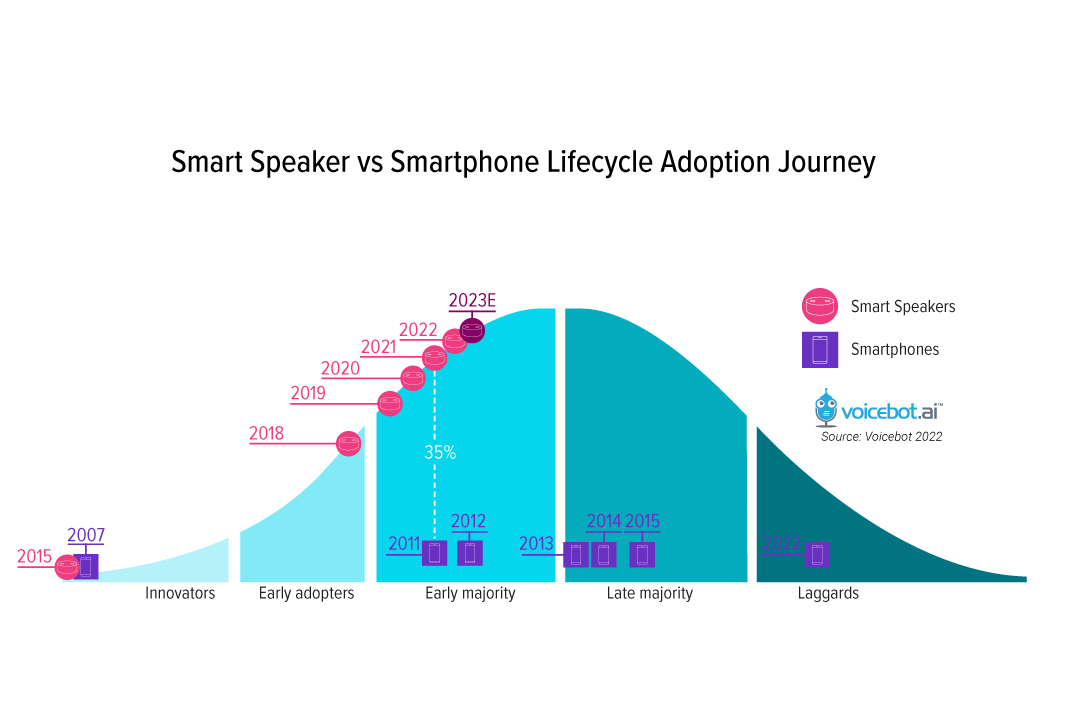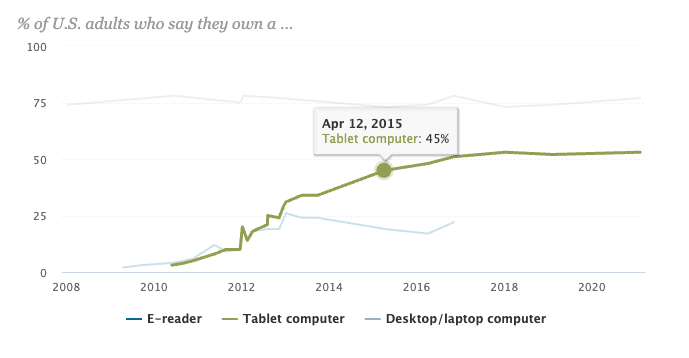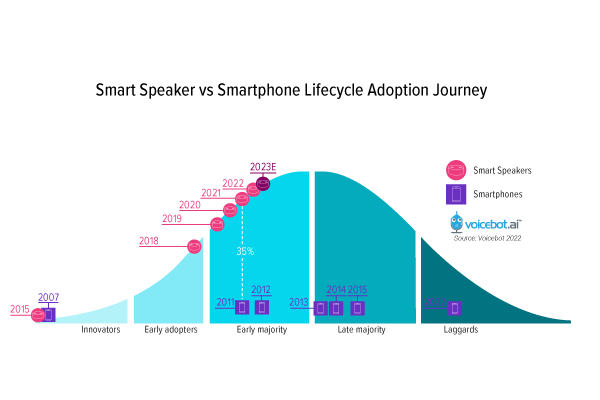Smart Speaker Adoption Diverges from Smartphones But That’s Okay
It was once popular to claim that smart speakers represented the fastest device adoption in history. Data show that simply isn’t true. However, being second to the smartphone or solidly in the top five of the modern era is actually quite spectacular. There is no need to downplay the smart speaker’s significance even while recognizing the smartphone remains king.
Voicebot analysis of smart speaker adoption in the fifth edition of the Smart Speaker Consumer Adoption Report out this past week breaks down five years of device sales in the U.S. The adoption penetration among U.S. adults was rapid between 2015 (when the Amazon Echo became generally available) and 2019. This same pattern can be witnessed using data from the UK and Germany with a two-year lag. However, after 2019, the U.S. adoption rate then began to taper.

High double-digit growth rates were replaced by low single-digit rates. That means it took smart speakers six years to reach 35% adoption among U.S. adults compared to just four years for smartphones. Both devices saw a slight slowdown after year four but smartphones accelerated again in year six cresting 50% ownership. Smart speakers are in year seven and it looks like it will take several more years to just hit 40% ownership.
Devices, Approach the Starting Line
Granted, this “fastest adoption ever” argument always rests on ambiguity. The most important variable is what you set as the date of the first item in the category. Should we start the smartphone clock in 1994 when IBM released its Simon personal computer? Or, maybe you’d prefer 2000 with the first phone with a camera. Or, you could more conceivably set the market genesis in 2001 when 3G and internet access first arrived on cell phones. An even stronger case could be made for the Blackberry 5810 creating the smartphone market in 2002.
Any one of these starting points would make smart speakers a faster growth market than smartphones over a five-year period. However, those caveats aside, these would all be considered feature phones. The first smartphone as we know it today was the iPhone. Introduced in 2007, it changed the way people thought about the devices and became the model every other manufacturer has attempted to replicate. Whereas Blackberry expanded the definition of cell phones as communication devices beyond talk, the iPhone expanded the category beyond communication and into everything.
So, Voicebot sets the iPhone launch as the beginning of the smartphone era. We set the introduction of smart speakers as the general availability date of the Amazon Echo in early 2015 given that the 2014 soft launch was restricted distribution. Using those dates we get smart speakers behind smartphones and it’s not really close anymore.
Smart Speaker Competition
With that said, the magic of smart speakers is only partly the device. They represent a significant advance in voice assistant technology. That technology is now available in many devices in the home. Voice assistants are now embedded in media players, smart TVs, and a few other appliances. While the presence of these other voice assistant vessels is not as widespread as some had predicted, it still undercuts the need for a smart speaker in some instances. That may be creating some downward pressure on the broader adoption of smart speakers.
The closest analogy for smartphones is the tablet. However, it turns out that the tablet was never really a substitute device but was complementary. Smart speakers in many ways are the new tablet. A smartphone can functionally do just about everything a smart speaker can. The smart speaker mostly offers enhanced convenience (through far-field microphones) and in some cases a larger fixed display and better audio. This is similar to the iPad. The larger screen offers a lot of benefits for many users and use cases but functionally it is actually less robust than a smartphone.
While we are talking about tablets we might as well acknowledge that there is an argument that these also demonstrated faster adoption than smart speakers. Again, it depends on what you mark as the first tablet computer. If you choose the GRiDPad that debuted in 1989, tablets have followed a much slower adoption path than many modern technologies. However, if you prefer the iPad as the first commercially successful consumer tablet as Pew Research does, then you see 45% adoption in the U.S. after just five years, well ahead of smart speakers.

A Model for Smart Speakers’ Future?
Using this approach you might say smart speakers are the third-fastest adopted technology. However, this misses the larger point. It is rare that any new consumer device achieves more than 30% adoption in just five years. Smart speakers are already in an elite company. In addition, the tablet might be an interesting model to consider when forecasting the future of smart speaker adoption.
You may note that tablets surpassed 50% adoption among U.S. adults and have held steady at that rate for around five years. There doesn’t seem to be any catalyst to spur further growth but we are also seeing those that adopted continue using the devices. The 50% ownership market looks like it might be an upper bound for a device like a smart speaker. With that said the deceleration in adoption occurred sooner for smart speakers so the equivalent plateau is likely to be somewhere around 40%.
That reality may disappoint a few people but it is still a very large market with over 90 million U.S. adults employing the devices and more than half of those are daily users. A new, irresistible consumer application could lead to a rapid increase in adoption. However, even if this doesn’t come to pass, there are still a lot of users in countries around the world that can readily adopt any new application that comes along. Distribution is available for those independent developers that want to leverage it. That is the result of smart speakers becoming one of the fastest adopted technologies in history.
A final point worth noting. Smart speakers are just one distribution channel for voice assistants and voice applications. The voice AI market is far larger than a single device. Smart speaker adoption may have stalled but voice-enabled interactions continue to expand into more corners of the digital world.
Get the Full Report
If you would like to learn more about the dynamics of the smart speaker market today, you can find more than 40 charts and 50 pages of analysis in the recently published Smart Speaker Consumer Adoption Report.
Download ReportUse the button above to access the report. Also, if you have any questions or want to share your thoughts on the findings feel free to message Bret Kinsella on Twitter.
Follow @bretkinsella Follow @voicebotai
The Rise and Stall of the U.S. Smart Speaker Market – New Report









